Katy Sullivan Hopes Making History on Broadway Heralds a Revolution
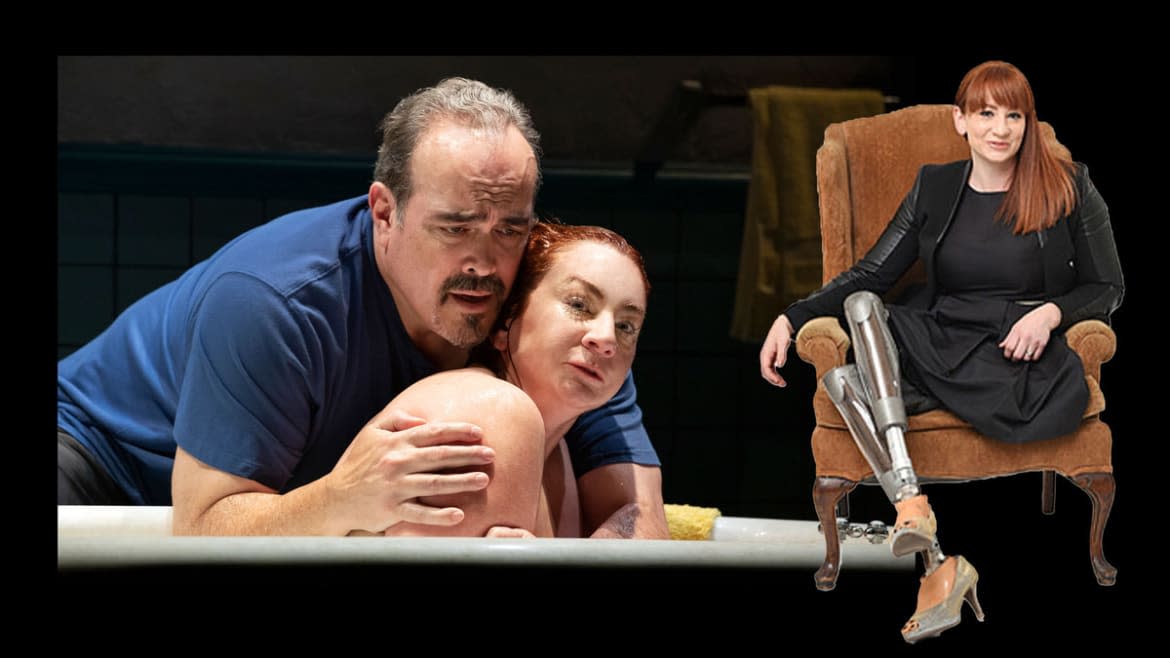
- Oops!Something went wrong.Please try again later.
A young girl recently stopped the actor and Paralympian Katy Sullivan after a performance of Cost of Living on Broadway, in which Sullivan plays a quadriplegic woman named Ani negotiating her new life after an accident and a complicated relationship with ex-husband Eddie (David Zayas).
“She asked to take my picture and said, ‘I want to thank you. I’ve never seen someone like me on stage. I love acting,’” recalled Sullivan, talking to The Daily Beast in a recent Zoom call. “And I said to her, ‘Don’t give up, don’t walk away from it.’ We’re at a tipping point where people want to see authentic stories of people with disabilities—the real thing. They don’t want to see able-bodied people sitting in a wheelchair.”
The ‘Cost of Living’ on Broadway Is Absolutely Worth It
Sullivan, who was born and raised in Alabama, is making history this season as the first female amputee to ever appear on Broadway. She has been playing Ani for around six years in productions of Martyna Majok’s Pulitzer Prize-winning play, first at the Williamstown Theatre Festival in 2016, then off-Broadway, then at London’s Hampstead Theatre, and now, in the Manhattan Theatre Club Broadway production (at the Samuel J. Friedman Theatre, to Oct. 30).
The play and Sullivan’s performance have already won awards, and rave reviews—and Tony Awards buzz has already begun. She was born without lower legs, is a bilateral above-knee amputee, and has worn prosthetic limbs all her life. In the play, her character has no lower limbs and is in a wheelchair.
Audiences, she has noticed, have been staying in the theater “for a little while to get themselves together at the end. This play has touched people. I think it’s something about the collective experience globally we’ve had in the last two years of isolation and loss, and being faced with your own humanity. I think this play is speaking to people in such a profound way.”
Sullivan laughs that she thinks the audience may have a harder time leaving Ani behind than she does after every performance. “I find so much joy in her now. I love her, but she lives at the Friedman Theatre.” They share a sarcastic sense of humor and are both very practical, but her portrayer is far more forgiving than Ani is towards Eddie.
By now, playing Ani is “like visiting an old friend,” said Sullivan. “What I love about her is her inability to have self-pity, and she has fleeting moments where she’s honest about her situation. I love her wit, sense of humor, and sarcasm. She’s so fun to play. Martyna’s writing is so sharp, one moment you will be slinging out some incredibly funny line and the next moment you’re cracked open and vulnerable. It’s an intense ride to go on, but what a gift to be able to play her.”
The flip side of the response to the young girl seeing herself represented has been an ignorance that speaks directly to a lack of representation of disabled bodies. One man, assuming her to be able-bodied, wondered how painful it was for Sullivan to be sitting on her feet, her legs folded underneath her in the wheelchair. A friend of Sullivan’s overheard someone in the bathroom wondering if it was a trick done with mirrors.
This lack of comprehension, a kind of unthinking ignorance, is “100 percent because we are culturally not used to seeing real disabled people on stage and so some audience members wonder, ‘What is the trick?’ It’s insane,” said Sullivan. She has even been asked why she doesn’t use a wheelchair for curtain calls by people who don’t realize she doesn’t use a wheelchair in her offstage life. Sullivan says that just as some actors say their characters click when they put their costume on, in the same way, Ani being in a wheelchair helps Sullivan separate herself from her character.
“The curtain call is the moment when you, as an actor, appear as yourself, and 99.9 percent of the time I use prosthetics. We had some of these comments off-Broadway, but that was five years ago. I assumed it would be different now, and it is in a lot of ways. But we have a long way to go culturally when it comes to representation. I do feel like we are at a tipping point. It’s been a long time coming, and it’s been incredible to be part of this wave of what’s happened.”
Sullivan hopes not only that representation is improving, but that disabled people are not seen as “inspiring” just by living their lives. “Why am I ‘inspiring’ because I left my house today? Look at that word. If I inspire you to make a change in your life or do something different than you have done before, I will accept that—but not if you say it’s so ‘inspiring’ to see me walk down the street on two prosthetic legs.”
“What I care about is parity, and true parity”
Cost of Living, in a very natural, unforced fashion, makes the audience consider the reality of disabled bodies. A shower scene featuring John (Gregg Mozgala), a graduate student with cerebral palsy and Jess (Kara Young, recently Tony-nominated for Clyde’s), a bartender who becomes his caregiver, reminds Sullivan of when a caregiver did the same for her ex-husband when they “talked about the basketball game the night before while doing this very intimate thing. Martyna, who was a caregiver, captures that in this really incredible way.
“As a society and culture, we’re sort of taught to look away from the disabled. ‘Oh, don’t make eye contact.’ If we see someone in a wheelchair or using some assistance device, it’s, ‘Don’t look, don’t talk, look away from the complexity of this.’ The genius of Martyna’s writing is the very first thing Gregg and I say are jokes. It completely breaks the ice and the audience’s discomfort. What starts with people feeling, ‘We don’t know how to feel,’ suddenly goes to ‘This is OK.’ That is what this play does so beautifully and complicatedly. It leads us into a world I’ve never seen portrayed in such an accurate way.”
As Sullivan says, the core of the play is not about disability, but, as Sullivan says, the need for human connection—and the two characters who need that most turn out to be the able-bodied characters, through grief and desperate material need.
Sullivan hopes that Cost of Living “is where we are headed—that we are seeing more of these stories and representations. Individuals with disabilities are the largest minority in this country, and absolutely the least represented on stage and across the board. Representing disability is a different challenge than with other minority groups, because just engaging and dealing with disability makes able-bodied people have to acknowledge their own humanity. Eventually, able-bodied people may have to use a cane, reading glasses, and hearing aids. None of us get out of life without some sort of challenge. By really looking, by really taking a hard look at disability, people have to confront the fragility of their own lives. That’s a hard thing to have to swallow. It’s scary.”
Sullivan recalled an interview she did, in which she was discussing an able-bodied person playing an amputee in a movie, and her interviewer said, “You have to give it to (unnamed actor). They did their research.”
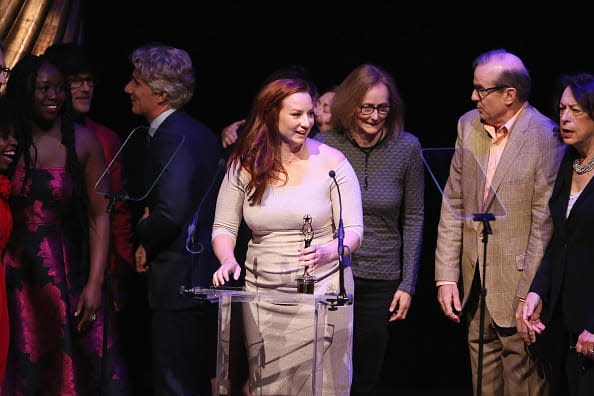
Katy Sullivan (center) and the cast of “Cost of Living” accept the award for Outstanding Play in a tie with “School Girls; Or, the African Mean Girls Play” at the 33rd annual Lucille Lortel Awards on May 6, 2018, in New York City.
Sullivan said, “I didn’t know what to say to that. At the end of the day, I don’t know if I care if able-bodied people play disabled characters. What I care about is parity, and true parity. I care about performers with disabilities having the same kinds of opportunities that able-bodied actors are getting. Why on that legal show shouldn’t X character be in a wheelchair or wear prosthetic legs? Why does that matter? It immediately adds an interesting texture to that character. Writers can lean into it without having the characters open their mouths.
“It’s about access and opportunities for people. Able-bodied actors can play disabled characters all day long if they want, as long as we can play all the characters we are able to play.”
Sullivan, who is in her forties, has seen some change in the opportunities she’s been getting, and the parts being written. “Early in my career in mainstream television, the disabled character was the ‘oh’ reveal at the end of a scene, it was supposed to be shocking. It was a plot device. There was nothing in between ‘tragedy’ and hero.
“I have to say this play specifically is none of that, and it is something starting to be reflected in my career on TV too. In Dexter: New Blood, my character Esther was the town gossip, funny and lovely—a sprinkling of humor in a really dark show. We never discover why she is in a wheelchair. It was not a plot point. She is just a character that an able-bodied person could have played. It was reflecting the real fabric of small-town America where some people are in wheelchairs.”
Representations of disability are deepening and improving, Sullivan says, as the Tony-winning success of Ali Stroker in the 2018 Bard Summerscape off-Broadway, 2019 Broadway revival of Oklahoma! showed. “People are looking outside the box now, and I’m looking forward to more of that being the norm.”
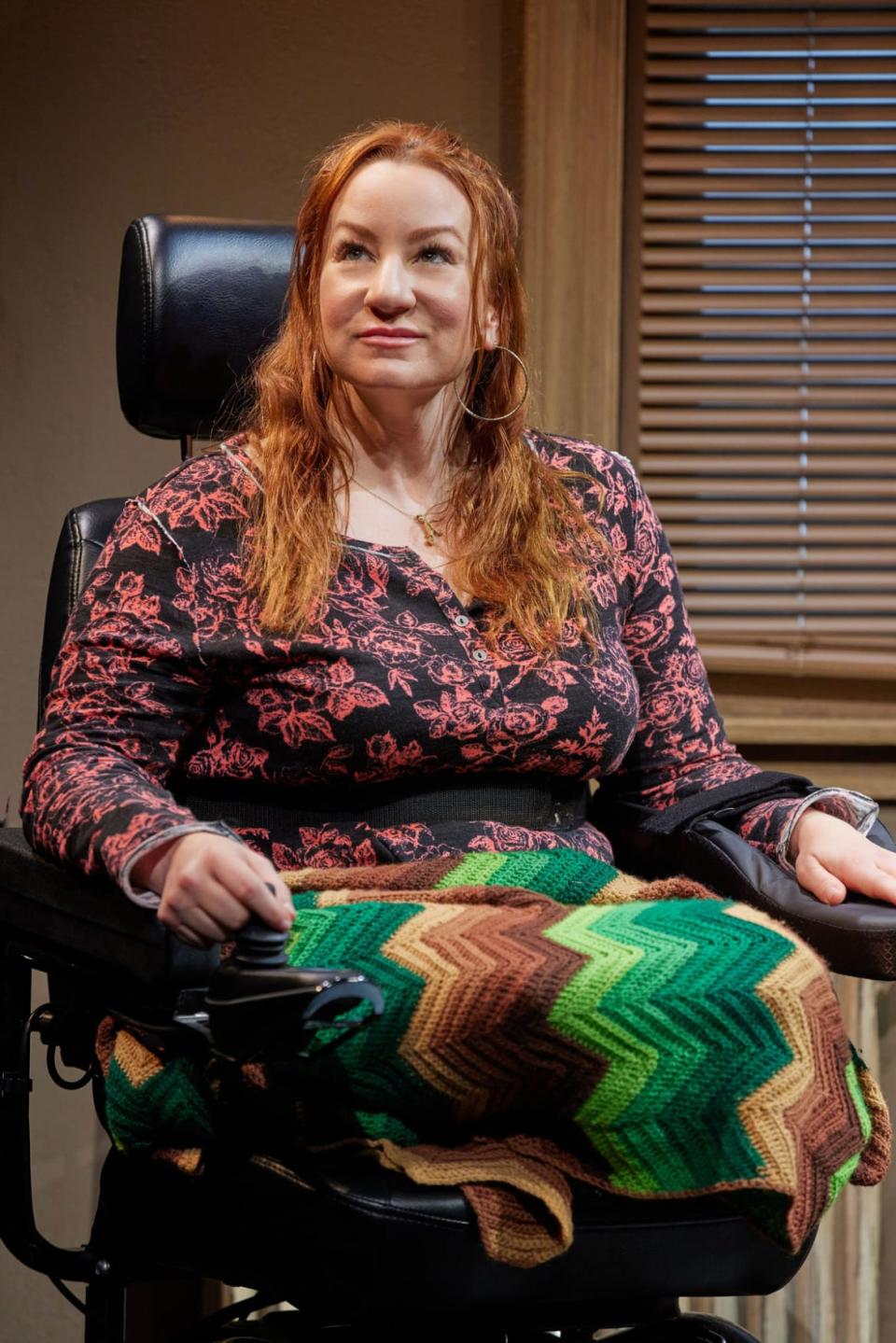
Sullivan is not indulging any of the Tony Awards buzz her performance has garnered. “For a theater kid who grew up in Alabama and who had no one to point to to say, ‘This is possible,’ just being here doing this is a dream come true—and making an impact in so many ways that I can’t even see. That being said, that’s not the kind of thing you can carry on stage every night. I can’t carry on to the stage that I am the first actress who’s an amputee on Broadway.
“Accolades and awards are an acknowledgment that you deserve to be here, and a member of a community that historically has not allowed you in. I think that matters not just for me but for that 7-year-old girl at home right now, singing a song and wanting to be a performer. I am humbled and honored to know that there’s a little 7-year-old girl who’s an amputee who can now point to someone.”
“Still to this day, I’m like, ‘Why not me?’”
Growing up, Sullivan’s parents—mother Barbara, a microbiologist, father Cornelius, a doctor—never tried to talk her out of anything, she says—although it doesn’t sound like there would have been much point in doing so.
“My parents said I started pulling myself up to stand when I was about one year old. They were like, ‘We better get some prosthetics. She’s going to walk.’ They really let me lead them. If I fell down, I had to figure how to get back up. There was that constant drive to adapt to a world that was not made for me. I was just born with this incredible determination to have this world work for me. I wish I could bottle and sell whatever that was.”
Sullivan laughed. “There was this tiny little kid in Alabama who was like, ‘Why not me?’ And still to this day, I’m like, ‘Why not me?’ I’ve done all the work, I’ve been to conservatory. I learned to be an actor. ‘Why not me?’ was just baked into my spirit. There have been things that I’m sure I lost out on along the way that I don’t even know about. But it’s never been like, ‘OK, maybe I should go be an accountant.” She laughed again.
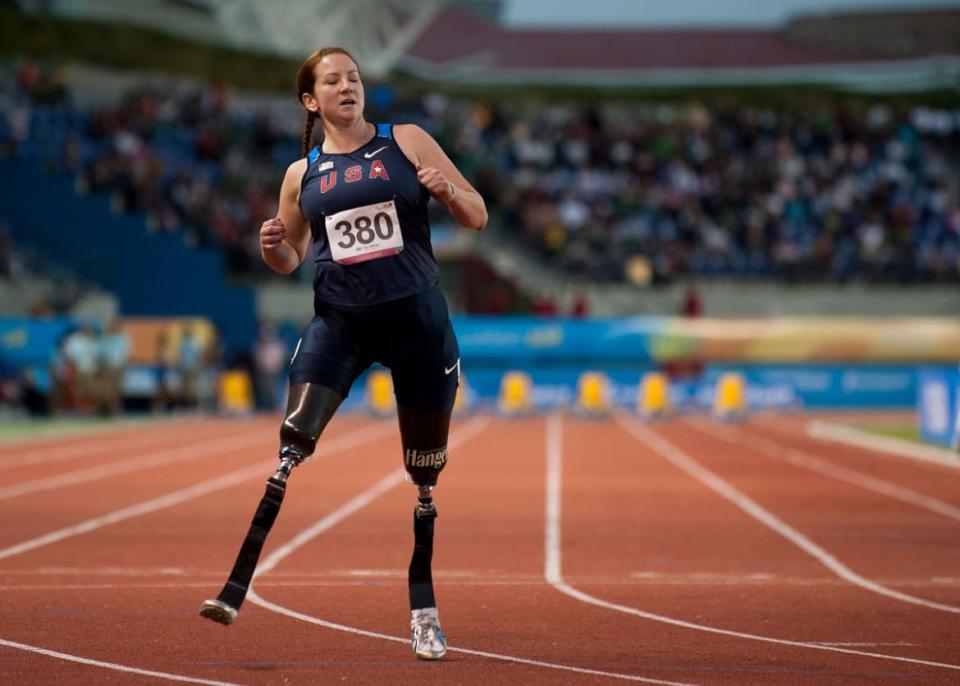
Katy Sullivan competes in the Women’s 100m T42 during Day 4 of the 2011 Para Pan American Games at Telmex Stadium on Nov. 16, 2011, in Guadalajara, Mexico.
Her siblings—Patrick, Daniel, and Maureen—are a lawyer, doctor, and work in finance. Sullivan laughed again. “I can pretend to be all of those things. And I do jazz hands! I am so not from a performing arts or acting family. They are all just over moon for me, and excited and all of that.”
As a little girl, Sullivan recalls seeing a production of Charlie and the Chocolate Factory, and she quotes Willy Wonka herself, “We are the music makers. And we are the dreamers of dreams.”
“I’ve always been a dreamer and to be in a place where dreams are actively coming true is so incredible,” she said. “There were plenty of years where I would have just one audition for an entire calendar year, which was frustrating and disappointing. There were years where I didn’t have any. I had agents submitting me for things. Of course, there was discrimination, and people just not willing to give me an opportunity. Was it that I didn’t have the skill set to play certain characters, or people just weren’t thinking outside the box?”
At 25, Sullivan ran using prosthetic blades for the first time, eventually becoming a Paralympian in the London Games of 2012. She had never run before. It was a time of not much acting work, and she first started doing it for exercise. “Then it started to take on a life of its own. I was encouraged to compete. The first track meet I went to I was so frigging terrified, I was so far out of my comfort zone, I said to my prosthetist, ‘Can’t I just sing the national anthem? I would rather do that than get into those blocks and run the 100m.’
“Then I used my experience as an actor. I kind of created an athlete character. It was so not the world I knew anything about or was used to. I grew up doing theater. This character would go to the gym at 4 in the morning, eat this not that—and I was very good at it. It was a crazy chapter in my life, and unbelievably humbling to represent my country.”
Sullivan was injured before the 2008 Beijing Games, falling on one side. There is a faint scar on her head where her sunglasses cut her. A residual after-effect is some arthritis in her neck and shoulders for which she sees a chiropractor today. In Cost of Living, her standout scene, in a bath, sees her, ever the pro, craning her neck out towards the audience to play the scene. “These are very first-world problems,” she says, noting the literal ache of doing that scene.
Sullivan said she knew she would not win a medal in London in 2012, “unless three people ate it at the beginning of the race. That took the pressure off. It became more about appreciating the experience and trying to run a personal best, which I did. I also set an American record that day and came in 6th in the world. It was an unbelievable ride and experience—another art imitating life thing, another piece of the life puzzle that is Katy Sullivan.”
She laughed, recalling doing an episode of NCIS: New Orleans years later featuring a scene with her character ending a scene and running off. She had her blades shipped from California to do the scene. Cost of Living is a very physical show for all four actors. While no longer competing at a Paralympian level on the track, Sullivan is still dedicated to working out. “My commitment to being an actor means it is paramount I stay healthy.”
While the role of Ani in Cost of Living is “beyond anything,” Sullivan says her breakthrough role was in a play called The Long Red Road, directed by Philip Seymour Hoffman at the Goodman Theatre, Chicago, in 2010.
“It was this moment one of the first times I ever got to play a character who was an amputee. She was so complicated, so complex, and broken. The hurt she was experiencing was such an emotional challenge to dig into, and Philip Seymour Hoffman helped me do that. That role made me think, ‘This is possible. I’m not going to just play plane crash victims or veterans.’ There were people out there seeing our stories as three-dimensional. I can point to that experience as life-changing. I feel like I got my masters degree in acting just by being with Philip Seymour Hoffman. And obviously to be here—Cost of Living has 100 percent changed the trajectory of my life.”
By this, Sullivan means by being in a Pulitzer-winning play on Broadway has meant there are “new conversations” about her abilities, new work, and other projects (one big one she says she cannot yet divulge).
Also, she added, when she first performed Cost of Living in 2016, her life was “entirely different.” She was living in Los Angeles and married to someone she is now amicably divorced from. Now she lives on the East Coast, is engaged to her present partner, and has a dog. “Cost of Living has indirectly or directly impacted my life on every level. My ex-husband is a quadriplegic. I would not have been able to portray Ani, understand her, and bring the level of humanity that I am bringing to this character if I had not had the experience I had of my ex-husband.”
Ani is also going through a divorce, and finding her ex again during the play. While that is not what happened with Sullivan she says of the play: “It is art imitating life imitating art, all of my life experiences are leading me to this place. At this point I don’t know do you separate all of that life and art spaghetti.”
“What is happening right in front of me?”
Sullivan’s father died a year and a half ago. “He knew this Broadway engagement was happening, which was lovely. He had experienced this play with me in its earlier productions, which is really meaningful. What has meant most to me before he passed was our last text exchange— which was me telling him I had booked Dexter and going to Broadway. I feel like he saw the breakthrough that was happening, which is a lovely place to leave that. He was so proud of me. His sisters are coming tonight. My mom was at the opening.”
Sullivan laughed. “She’s my loudest cheerleader, my biggest fan. She steals my thunder, and texts everybody my career news. She’s so proud that she gave birth to this kid who had no legs. ‘Oh God, what is this cruel world going to do to this human.’ For her to have seen me run at the London Paralympics and seen me do the opening night on Broadway, and fill-in-the-blank. Who knows what else is coming? I can’t even imagine the level of pride she feels.”
When this reporter asked what Sullivan would like to do next, she laughed, referencing her dramatic bathing scene in Cost of Living. “I would love to play a character who stays dry—a world where all the water has gone, a post-apocalyptic desert world. That sounds great.”
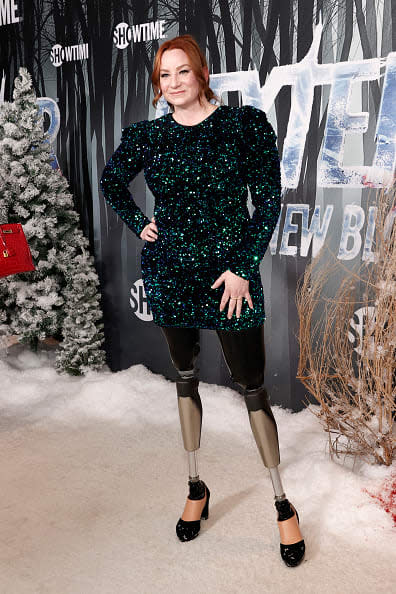
Katy Sullivan attends the “Dexter: New Blood” world premiere at Alice Tully Hall, Lincoln Center, on Nov. 1, 2021, in New York City.
Sullivan loves the specificity of television—“My Type A personality loves figuring out when to pick up a glass of water”—and she is currently working on a TV show with writer and producer Georgia Pritchett (Veep, Succession) about a Fleabag-ish dark comedy about a female amputee, “who thinks not having legs is the least of her problems,” Sullivan says, in which she would play the lead.
“She’s really not a good person. When I walk down the street, and somebody thanks me for my military service I kindly correct them. This character would say, ‘You’re welcome, and I’ll take a vodka soda.’ A child might ask her what happened to her legs, and instead of saying kindly, ‘You know how you were born with brown hair, well I was born with no legs,’ this character would say, ‘Shark attack,’ or make up some horrible lie. I love how complex human beings are. No one is 100 percent good, or 100 percent bad. Whether we want to admit it or not, those dark places are in all of us somewhere.”
But for now, the future can wait. Sullivan wants to immerse herself in Cost of Living on Broadway. “My whole goal for this thing is to remain present,” Sullivan said, “to not get ahead of myself—not to think ‘What next?,’ but rather ‘What is happening right in front of me?’ I want to soak up the entire experience.”
Cost of Living is at the Samuel J. Friedman Theatre, until Oct. 30
Get the Daily Beast's biggest scoops and scandals delivered right to your inbox. Sign up now.
Stay informed and gain unlimited access to the Daily Beast's unmatched reporting. Subscribe now.

